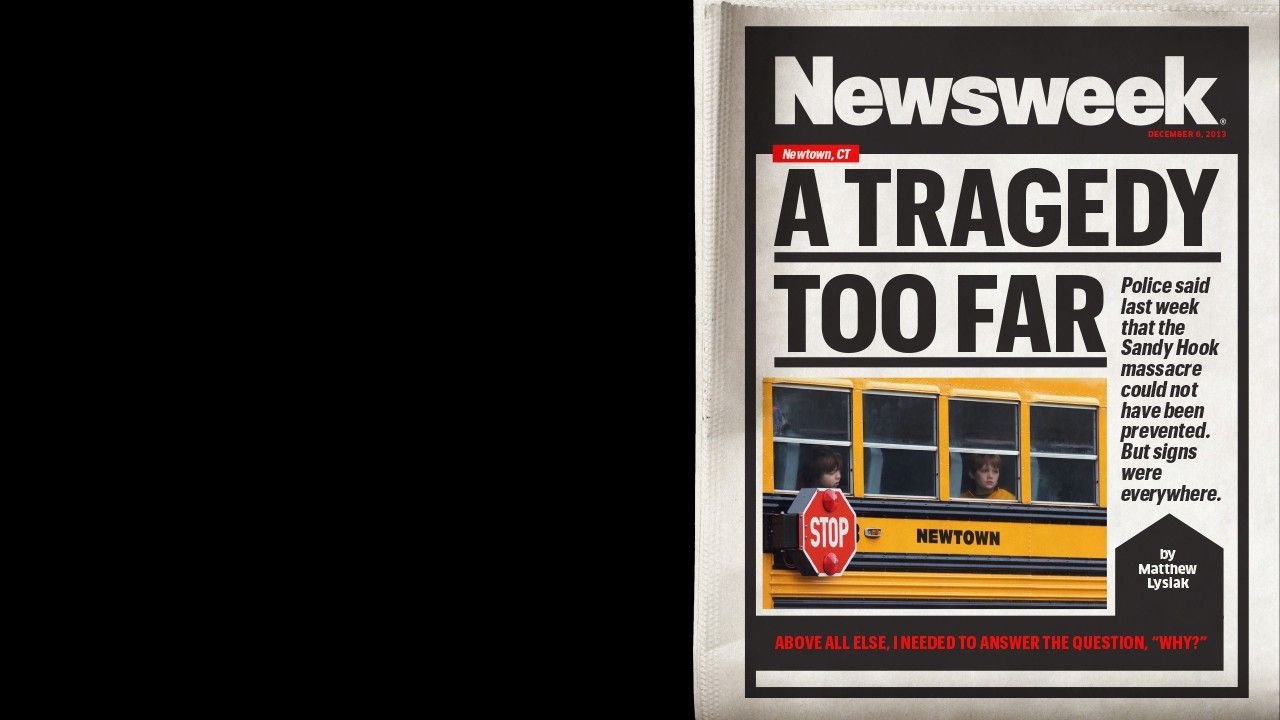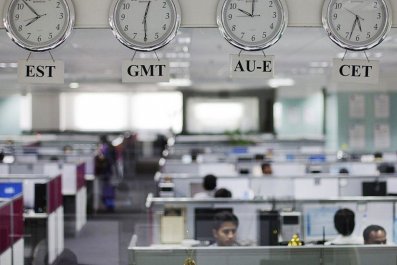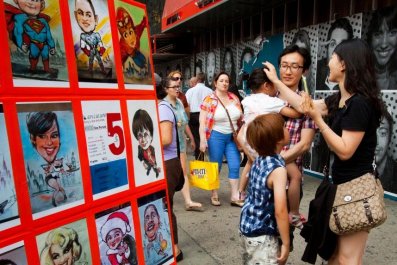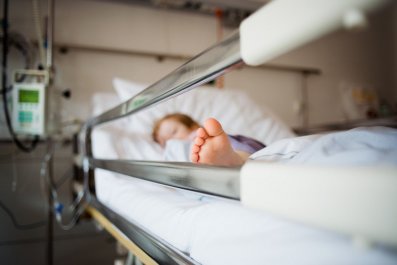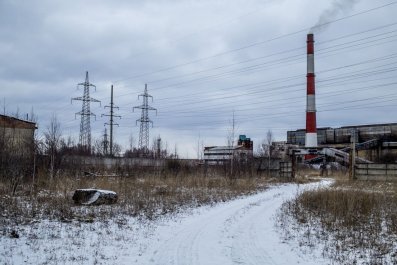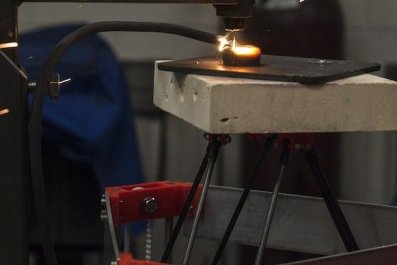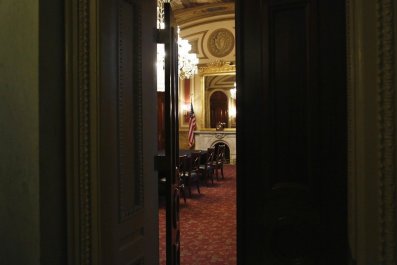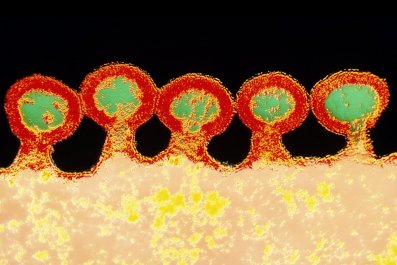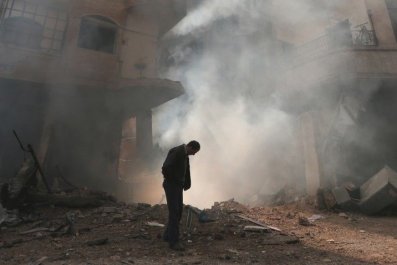On the afternoon of December 14, 2012, I was on the phone, battling with my wife. It was a carryover from the night before, a fight about a dress she wanted to buy for our daughter to wear to her first-grade Christmas play. My argument was simple: She would wear it once, and then it would be forever banished to a far corner of the closet. A waste of money.
At the time, I was sitting in my car, deep on Long Island, parked outside the house of a man whose car was linked to a mob-style hit a few days before in midtown Manhattan. The stakeout wasn't going anywhere, but since the story was on the top of the New York media news cycle, neither was I.
Then the AP alert hit my iPhone; 20 children had been murdered inside an elementary school in Newtown, Conn. Several adults, including teachers, had also been murdered by a young man with semiautomatic weapons who had walked into the Sandy Hook Elementary School and methodically shot everyone in his path.
What was my reaction? Horror? Grief? Confusion? No. I wasn't having any of the feelings that would be expected from a normal human being. Instead, I was instantly flushed with adrenaline. I wanted to get to the scene and get the facts. And, above all else, I needed to answer the question, "Why?"
I told my wife there had been a shooting, and I wouldn't be making it to our daughter's play. She didn't ask when I would be back; she knew it was a question without an answer. I mapped out the route to Newtown on my iPhone, pulled away from my stakeout, and began the two-hour drive.
Moments like this had become the new normal in my life. As a reporter for the New York Daily News I had covered almost every major U.S. tragedy over the past seven years.
I was on the ground in Tucson, Ariz., jotting down notes from witnesses who described Jared Loughner's sick look of amusement as he gunned down Congresswoman Gabrielle Giffords and several more in a supermarket parking lot. I was in Aurora, Colo. watching a young woman screaming in agony for answers at a memorial after James Holmes began firing bullets into on an unsuspecting movie theater audience. I was in Fort Hood, Texas, the day Nidal Malik Hasan, a U.S. Army major and psychiatrist, shot 43 people, killing 13. I was in Binghamton, N.Y., listening to an injured survivor describe in painstaking detail how he had lain still on the floor of the American Civic Association immigration center, draping his body over his wife's to protect her after gunman Jiverly Voong started shooting. He recalled in hysterical sobs the moment he realized his wife was no longer breathing - a bullet had hit his arm and struck her in the chest. How would tell his children that their mother was gone forever?
It was demanding work, but it provided the kind of intellectual stimulation most journalists dream about. On an almost daily basis, I was sharing the most intense moments in the lives of total strangers. I always felt it was a sacred honor to share these raw moments of pure grief.
But my job also meant that I was away from home for almost six months of every year. My wife was incredibly supportive - she gave up a writing career of her own to stay at home with our three children while I hopped around the country chasing disasters.
Our three young daughters - ages 9, 6, and 2 - gave up far more. The family vacations, often cancelled at the last minute, and missed milestones too numerous to count had become another new normal.
There was the day the family camping trip had to be scrapped after the girls had spent all day carefully laying out their supplies because oil from a BP spill was strangling the Gulf. It became a running joke in our house that carefully planned birthday parties meant big news was on the verge of breaking. One time, two fire trucks collided in Queens. Another time, it was in Brooklyn after a hurricane.
My kids became numb to the overly recited speech about how important my job was. I always promised to bring back presents. Lots of presents.
But I loved my work and working on the biggest stories in the world for the fifth-biggest paper in the country. While not a lucrative career, the overtime afforded me enough to comfortably provide for my family. No small thing in this economy. I believed I was living a charmed life.
As I drove to Newtown, I tried to gather as much information as possible and come up with a plan. I knew other reporters were already on the ground getting information. I drove with one hand on the wheel, the other surfing the Internet for information. The shooter's name had already been released - Ryan Lanza. He even had a Facebook profile.
I passed countless other reporters on the road, marked by their press plates, in the morbid caravan heading to a small town in Connecticut. We all wanted the same thing, to discover the motive for this massacre.
By the time I arrived in Newtown several Daily News photographers were already on the scene. Police had barricaded Dickenson Drive, the small road leading up to the school, so I drove by without stopping.
I knew that day one on the scene of any major tragedy is akin to sitting for hours in a locked cage. To maintain order, the police create small pens for the press, and occasionally they come by, feeding some dribbles of information. But the real information is out with the people from the town. I needed to talk to as many of them as possible.
I called the rewrite man in New York City for an update on what I was walking into. By now the name Ryan Lanza had been replaced with that of his brother, Adam Lanza, as the suspected shooter. We did not have pictures of Adam, so I needed to find one.
I found a nearby Dunkin' Donuts and got to work.
It was about 3 p.m. when I pulled up to the coffee shop, which was in the middle of a small shopping complex. I saw a crowd of young adults and teenagers standing outside in small circles with their hands in their pockets. It was well below freezing. Few words were being exchanged. Not a lot of tears. People just wanted to be together. At St. Rose of Lima a crowd had gathered. Two miles down the road another crowd had huddled in the parking lot of the Colony Diner. No one wanted to be alone.
I began working the crowd, asking the same question again and again, for hours: Do you know Adam Lanza?
From the hundreds of people who shuffled in and out of the Dunkin' Donuts over the next few hours I occasionally got tiny pieces of information. I instantly emailed them to my editors and the rewrite desk. I looped in our other reporters on the scene so our information was coordinated.
"He was a quiet genius."
"He couldn't feel pain."
"He always looked scared. Like someone was about to hit him."
"He was a dork."
"Kids used to pick on him."
"He was weird."
"He went to the high school first. He was banging on the door, but couldn't get in."
Two hours had passed before the rewrite desk called again. He wanted to remind me that no one had a photograph. Finding a picture of Adam Lanza should be my number one priority. By now, I had many locals willing to help me - they wanted answers too. Many began placing calls to their friends and classmates. Some even brought their yearbooks to the table I had taken over at the Dunkin' Donuts. We raced through pages, looking for traces of Adam.
I was having no luck - under Adam Lanza's name in his 10th grade yearbook appeared the words "Camera Shy." I scoured social media sites for information on him. In the new world of journalism Facebook and Twitter had become indispensable tools for gathering information, especially pictures. But there was no trace of Adam Lanza online. Not even a Facebook account.
Most of the people who live in Newtown knew little more about the killer than I did. I was either very unlucky, or this was a person that had somehow remained anonymous, an almost unthinkable thought for a 20-year-old man in our digital age.
The adrenaline wore off sometime after 2 a.m. I eventually left the Dunkin' Donuts. I hadn't thought about where I would stay. Every hotel in the nearby vicinity was booked. I found a Hampton Inn 20 miles away.
Saturday and Sunday were a blur of chasing leads. Most of them dead ends. The Daily News had a team of six reporters so we split up the tasks. Most worked to find information about the innocent victims. My job was to find information on the Lanzas.
By Monday I had put more pieces together. I had found a source close to the shooter's mother, Nancy Lanza, Adam's first victim, who was shot in her bed as she slept. Now, in death, Nancy Lanza was being scrutinized for surrounding her son with weapons like the Bushmaster rifle used in the shooting. Nancy's friend was angry at the way she was being portrayed in the media and wanted to get the truth out. He agreed to speak to me if I promised to withhold his identity.
He told me Adam was mentally ill, and Nancy had tried to get him help. He said Adam was afraid to leave the house, and that Nancy had wanted to move but Adam resisted. He had emails and text messages to back it up. Slowly, the narrative began to come together of a family in crisis in the days before the massacre.
Normally, a major break like this in a national story would be reason to celebrate, but I wasn't high-fiving. My editors were thrilled, but I sensed there was something wrong with me.
As the pictures of the young victims were being released, I noticed that I couldn't look at them. It was subconscious at first - I told myself I needed to focus on my job of learning more about Adam, but as more time passed I realized I was going to great lengths to avoid seeing the boys and girls who had been killed - not turning on a television, glancing past the page in the paper, walking straight past the memorials.
Early Tuesday morning I was grabbing a quick breakfast in my hotel lobby when I caught a glimpse of what was on the television screen. Above me were images of several of the murdered girls. They were all smiling and beautiful - like my own daughters.
I walked to my car, unlocked my door, sat down behind the wheel and sobbed.
I cried for the victims and the families, and I cried for myself and for my children.
Finally, I began to feel what the rest of the country was feeling. I felt physically ill.
It was a few minutes before I managed to pull myself together enough to meet a co-worker in the hotel lobby. I told her I didn't feel well and needed to spend an hour or two in my hotel room. I told my editors I was going to keep chasing leads on Adam, and they left me alone. I turned the ringer off and got back in the shower, trying to restart my day. My composure came back quickly, but the physical sensation of nausea stayed in the pit of my stomach until I left Newtown five days later.
A few weeks later I was back to speak with Mark Barden, whose son Daniel had been one of Adam's victims. By now many of the parents had come together to push for new gun legislation and were meeting with members of the press.
I met his press official, hired by the public relations firm at the Newtown Town Hall. He walked into a large room where Barden was sitting, waiting to tell the story about his son, and talk about what is wrong about current gun laws. The pain on his face as he described his son, and his agony over the loss of the future moments that were cruelly taken from him, will stay with me the rest of my life.
"You just keep replaying moments," he told me. "You wish you could go back in time. Have more moments."
I said what everyone says, "I'm so sorry."
Later that day, I spoke with Nicole Hockley, who lost her son Dylan in the shooting. "I know I'll never get my son back," she said. "That's a fact I live with every moment of every day."
They both spoke of lost moments, and I thought of my own.
Right then, I decided I would quit my job at the News.
But first, there was one more story I needed to tell. I wanted to tell the story of Newtown as fully and completely as possible. Every good reporter has a deep desire to make sense of the world around them. I needed to understand what had happened there.
I knew the story was too big for the 800 words reporters are given in newspapers. With so little space context gets lost. By the end of April I decided to take a leave of absence to write a book. I moved up to Newtown to research and write. As I said goodbye to my family, I promised it would be the last time I would be gone for an extended amount of time.
The one year anniversary of the shooting is next week, and my book is about to be released. The story Newtown: An American Tragedy tells is much bigger than a shooting. I was able to obtain thousands of emails that lay out Adam Lanza's lifelong struggle with mental illness, starting with his awkward childhood and fear of being touched. That scared little boy turned into an isolated young adult surrounded by violent images that soon grew into an obsession. The police report on the shooting that came out last week seemed to say that no one could have foreseen this terrible tragedy, but my book comes to a different and disturbing conclusion. Through my research, I learned that the warning signs were everywhere and this tragedy could have been prevented.
It's easy to understand why Adam Lanza felt at war with reality. Living was torture for the young boy - bright lights, loud sounds, even a touch could cause him to withdraw and become nonverbal. He became obsessed with violence to a degree that was abnormal even in today's desensitized society. Violent pictures. Violent writings. Violent poetry. Hours spent playing violent video games and researching weapons and serial killers on the Internet. Adam Lanza created a world in which he was surrounded by death.
His mother sought professional help. Therapists. Specialists. School counselors. Her friends often described Nancy Lanza as a hard woman to please, especially when it came to Adam. As far as she was concerned, no one was willing to do what it took to give her son the help he needed. Over time, the desperate mother began to believe everyone had given up on her son.
And of course there is the issue of her guns. How a mother who had devoted most of her life to the care of her troubled son obsessed with violence could keep several semiautomatic guns in the house is a question my book isn't able to answer. I doubt anyone ever will.
I think a lot about Richard Novia. He had been Adam's advisor during his freshman and sophomore years in high school. Nancy Lanza had told him of her son's special needs, and that he had been the victim of bullying. Novia paid extra attention to the awkward young teen and gradually began to see improvements. But before the beginning of Adam's junior year Novia decided to change jobs. When Nancy found out, she pulled Adam out of school. Novia pleaded with Nancy to keep Adam in school, arguing that without the structure Newtown High provided, all of the progress her son had made would be lost as he withdrew into his own world.
Nancy also had her own health concerns, and began traveling more, while Adam stayed home alone, plotting.
Now Novia has sleepless nights, wondering whether things would have been different had he stayed at Newtown.
After the book was completed in June, my wife and I decided to move out of New York City. We bought an old bed-and-breakfast in a small town in Pennsylvania. She is going back to school to get her teaching credentials, and I'm a stay-at-home dad. My day is spent changing diapers, running the older girls to choir practice, attending parent-teacher conferences and making a lot of soup with local veggies from the farmers' market.
There is a lot I miss about my old life. I miss the adrenaline. I miss many good friends and co-workers. But there is a lot I've gained. The arrival of fall this year meant birthday parties for my oldest two daughters. I was there for both of them.



